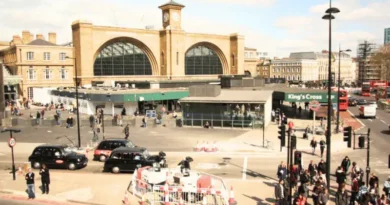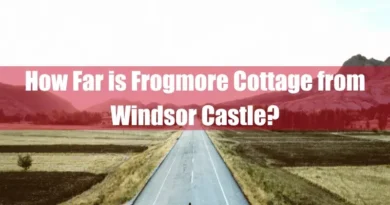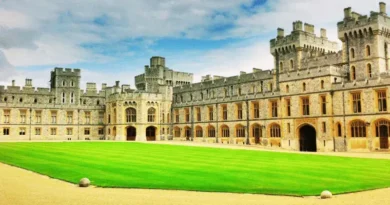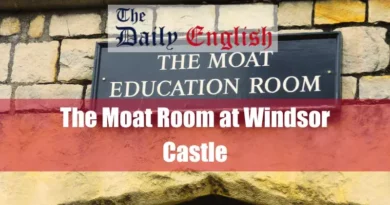Is Windsor Castle Worth Visiting?
Yes, Windsor Castle, the world’s oldest and largest occupied castle, is a significant piece of British heritage. Visitors often praise its rich history, stunning architecture, and well-preserved artefacts. Highlights include the State Apartments, St George’s Chapel, and Queen Mary’s Dolls’ House. The free audio guide enhances the experience by providing detailed insights into the castle’s past. However, some guests note that it can be crowded, leading to queues, and photography is restricted in certain areas. Despite these minor drawbacks, many find the visit worthwhile and recommend allocating several hours to appreciate the site fully.
Takeaways
| Key Points |
|---|
| Windsor Castle, the longest-occupied palace in Europe, has served as a royal residence since Henry I, functioning as a court, a venue for diplomatic events, and a refuge during conflicts, while today, it remains a favoured weekend retreat for the monarch and hosts state visits and ceremonies. |
| Visitors can explore key attractions such as the opulent State Apartments, the ceremonial Waterloo Chamber and Crimson Drawing Room, the historic rooms of Charles II and George IV, the richly decorated Semi-State Rooms, Queen Mary’s Dolls’ House, and the magnificent St George’s Chapel, which houses royal tombs and hosts weddings. |
| The castle also features the famous Changing the Guard ceremony, the 14th-century Undercroft Café, and a variety of exhibits, including the Moat Room and China Museum, while accessibility provisions and guided tour options enhance the visitor experience. |
| Recommended visits last 2.5 to 3 hours, and while most guests praise the castle’s historical richness and well-organised tours, some note crowding and mobility challenges, despite accessible facilities. |
| Easily reachable via train or car, Windsor Castle remains a prime attraction alongside nearby Windsor Great Park, Eton, and the Theatre Royal, offering a comprehensive blend of history, culture, and ongoing royal significance. |
Introduction
Windsor Castle, located in Berkshire, England, stands as a testament to nearly a millennium of British history. As the world’s oldest and largest occupied castle, it has been a continuous residence for British monarchs since its establishment. Today, it remains a working royal palace, attracting visitors from around the globe who come to explore its rich heritage and architectural splendour.
Historical Background
Founding by William the Conqueror
Around 1070, William the Conqueror selected the strategic site for Windsor Castle, perched high above the River Thames and adjacent to a Saxon hunting ground. By 1086, the initial construction was complete, serving both as a defensive fortress guarding the western approach to London and as a royal residence due to its proximity to a hunting forest.
Evolution through the Centuries
Over the centuries, Windsor Castle underwent significant transformations. In the 13th century, Henry III built a luxurious royal palace within the castle. Edward III expanded it further in the 14th century, resulting in one of England’s most expensive secular building projects of the Middle Ages. The castle withstood a prolonged siege during the First Barons’ War and played various roles throughout the English Civil War. Subsequent monarchs, including Charles II and George IV, made extensive renovations, contributing to the castle’s current architectural grandeur.
Role as a Royal Residence
Since the time of Henry I, Windsor Castle has been used by the reigning monarch and is the longest-occupied palace in Europe. It has served as a royal court, a venue for diplomatic entertainment, and a refuge during times of conflict. In modern times, it remains a favoured weekend home for the monarch and continues to host state visits and ceremonial events.

Key Attractions Within Windsor Castle
Windsor Castle offers a wealth of historical and architectural marvels that captivate visitors. Each section of the castle provides a unique glimpse into its storied past and royal heritage.
State Apartments
The State Apartments are a series of grand rooms that serve as the setting for official state occasions. These rooms are renowned for their opulent design and house an extensive fine art and antique collection.
Ceremonial Rooms
The Waterloo Chamber and the Crimson Drawing Room are among the most notable ceremonial rooms. The Waterloo Chamber was constructed to commemorate the defeat of Napoleon at the Battle of Waterloo and is adorned with portraits of key figures from the era. The Crimson Drawing Room features rich red decor and intricate detailing, reflecting the castle’s rich history.
Historic Rooms
Visitors can explore rooms built for Charles II and private apartments created for George IV. These spaces offer a glimpse into the personal lives of past monarchs, showcasing period furnishings and decor that have been meticulously preserved.
Semi-State Rooms
The Semi-State Rooms are among the most richly decorated interiors in the castle. Used by the Queen for official entertaining, these rooms are open to the public during winter, providing insight into the more private areas of royal life.
Queen Mary’s Dolls’ House

Built between 1921 and 1924 for Queen Mary, this exquisite dolls’ house is a masterpiece of craftsmanship. Designed by Sir Edwin Lutyens, it features contributions from over 1,500 artists and craftsmen, including fully furnished rooms, running water, and electricity.
St George’s Chapel
An architectural gem, St George’s Chapel is a prime example of English Perpendicular Gothic design. It has been the site of numerous royal weddings and houses the tombs of ten monarchs, including Henry VIII and Charles I. The chapel remains an active place of worship and is integral to the spiritual life of the castle.
Changing the Guard Ceremony

The Changing the Guard ceremony at Windsor Castle is a popular attraction and a quintessential display of British pageantry. Visitors can witness the precision and tradition of the guards as they hand over their duties in a formal ceremony accompanied by a military band.
Undercroft Café
For a respite during the visit, the Undercroft Café offers a selection of refreshments in one of the oldest surviving spaces in the castle. Dating back to the 14th century, this vaulted cellar provides a unique dining experience amidst centuries-old architecture.
Each attraction contributes to the rich tapestry of history and culture, making Windsor Castle a must-visit destination.
Visitor Experience
Tour Options
Multimedia Guides
Visitors to Windsor Castle can enhance their experience with complimentary multimedia guides. These devices provide in-depth information about the castle’s history, architecture, and notable artefacts, allowing guests to explore at their own pace.
Guided Tours
For those seeking a more structured visit, Windsor Castle offers exclusive evening tours. These guided experiences provide unique insights into the castle’s rich heritage and are available at specific times.
Accessibility
Windsor Castle is committed to accommodating all visitors. Concessionary rates are available for individuals with disabilities, and a complimentary access companion ticket can be booked online. The castle is situated atop a steep hill, and the visitor route covers long distances, so comfortable footwear is recommended. Accessible facilities, including a café, toilets, and a Changing Places facility, are available on-site.
Facilities
The castle provides a range of amenities to ensure a comfortable visit. In addition to accessible restrooms and dining options, there are designated areas for visitors to rest during their tour. The on-site café offers a selection of refreshments, allowing guests to relax and recharge before continuing their exploration.
Recommended Visit Duration
To fully appreciate the extensive offerings of Windsor Castle, it is recommended that visitors allocate between 2.5 to 3 hours for their tour. This duration allows ample time to explore the State Apartments, St George’s Chapel, and other significant areas without feeling rushed.
Visitor Feedback and Reviews
Positive Experiences
Many visitors commend Windsor Castle for its well-organised tours and the richness of its historical displays. The audio guides receive particular praise for enhancing the overall experience. Guests often highlight the magnificence of the State Apartments and the solemn beauty of St George’s Chapel as standout features of their visit.
Common Criticisms
Some visitors note that certain castle areas can become crowded during peak times, which may detract from the experience. Additionally, the steep inclines and extensive walking required can pose challenges for individuals with mobility issues despite the castle’s efforts to provide accessible facilities.
Overall Satisfaction
Overall, visitors express high levels of satisfaction with their Windsor Castle experience. The combination of historical significance, architectural grandeur, and well-curated exhibits contributes to a memorable visit that many deem well worth the effort.
Practical Information
Opening Times
Windsor Castle welcomes visitors throughout the year, from Thursday to Monday. It is advisable to check the official website for the most current opening hours and any scheduled closures before planning your visit.
How to Get There
The castle is conveniently accessible via public transport. Regular train services run from London Paddington and London Waterloo to Windsor & Eton Central and Windsor & Eton Riverside stations, respectively. Both stations are a short walk from the castle entrance. For those driving, parking facilities are available in Windsor town, though spaces can be limited during peak periods.
Nearby Attractions
In addition to the castle, the town of Windsor offers several attractions worth exploring. The picturesque Windsor Great Park provides scenic walking trails, while the Theatre Royal Windsor hosts a variety of performances throughout the year. With its historic college, the nearby town of Eton is also within walking distance and offers charming shops and eateries.
Conclusion
Windsor Castle presents a rich tapestry of British history, culture, and architecture. Its comprehensive visitor amenities, engaging tour options, and the allure of nearby attractions offer a fulfilling experience for those seeking to delve into the nation’s royal heritage. While some challenges exist, particularly concerning accessibility and crowd management, the overall visitor sentiment remains overwhelmingly positive. A visit to Windsor Castle is not only an opportunity to witness living history but also to partake in the enduring legacy of the British monarchy.
FAQ
What makes Windsor Castle historically significant?
Windsor Castle, established by William the Conqueror in the 11th century, stands as the world’s oldest and largest occupied castle. Serving as a royal residence for over 900 years, it has been the backdrop for numerous historical events and remains a working palace today.
What can I expect to see in the State Apartments?
The State Apartments are lavishly furnished with treasures from the Royal Collection, including masterpieces by renowned artists like Rembrandt and Rubens. Each room reflects the exquisite tastes of past monarchs and offers insight into royal ceremonial spaces.
Why is St George’s Chapel a must-visit?
St George’s Chapel is a stunning example of Gothic architecture and serves as the spiritual home of the Order of the Garter. It’s the final resting place of notable monarchs, including Henry VIII and Queen Elizabeth II, and has hosted significant royal weddings like Prince Harry and Meghan Markle.
What is Queen Mary’s Dolls’ House?
Queen Mary’s Dolls’ House, completed in 1924, is a remarkable miniature residence featuring working electricity, running water, and a collection of tiny books and artworks. It’s a testament to early 20th-century craftsmanship and offers a unique glimpse into royal life.
When can I witness the Changing of the Guard ceremony?
The Changing of the Guard at Windsor Castle is a vibrant display of British pageantry. Typically held at 11 am on select days, it offers visitors a glimpse into royal traditions. Checking the schedule in advance is advisable, as timings can vary.
What are the Semi-State Rooms?
The Semi-State Rooms, open to the public from September to March, were designed for George IV and are among the castle’s most lavish interiors. They provide insight into the private quarters used for official entertaining.
What is the significance of the Grand Reception Room?
The Grand Reception Room at Windsor Castle is adorned with gilded walls and magnificent chandeliers, reflecting the opulence of royal entertaining spaces. It’s a highlight of the State Apartments tour and showcases the grandeur of the monarchy.
Why visit the Waterloo Chamber?
The Waterloo Chamber commemorates the defeat of Napoleon and is adorned with portraits of key figures from the era. Its historical significance and grandeur make it a must-see for history enthusiasts.
Are there dining options within the castle?
Yes, the Undercroft Café, situated in a 14th-century space, offers a range of refreshments, including sandwiches, wraps, salads, and sweet treats. It’s an ideal spot to relax during your visit.
What art collections are housed in Windsor Castle?
Windsor Castle’s extensive art collection includes works by masters such as Rembrandt and Canaletto. These pieces are displayed throughout the State Apartments, enriching the visitor experience with world-class art.
What can I learn from the Moat Room?
The Moat Room features detailed models illustrating the castle’s development over nearly a millennium, providing context to its architectural evolution and offering insights into its rich history.
What is displayed in the China Museum?
The China Museum displays exquisite porcelain pieces from the Royal Collection, including items from China and Japan, reflecting centuries of royal collecting and the global reach of the British monarchy.
What are the Horseshoe Cloisters?
Built-in 1479, the Horseshoe Cloisters showcase medieval architecture and have housed College of St George members for centuries. Their unique design adds to the castle’s charm and historical depth.
What is the history of the Curfew Tower?
Dating back to 1227, the Curfew Tower is one of the castle’s oldest structures. It once served as a prison and adds to the rich tapestry of Windsor’s history, offering a glimpse into its medieval past.
What is the Garter Service?
The Garter Service, held annually in St George’s Chapel, is a tradition dating back to 1348. Members of the Order of the Garter gather in a colourful procession, showcasing centuries-old customs and the enduring significance of this chivalric order.
What can I explore in the town of Windsor?
Beyond the castle, the town of Windsor offers historic streets, a variety of shops, and the scenic Long Walk leading into Windsor Great Park. It’s a charming area to explore, rich in history and local culture.
How does Windsor Castle’s architecture stand out?
Windsor Castle’s architecture is a harmonious blend of medieval fortifications and Gothic grandeur. Its iconic Round Tower, constructed in the 12th century, stands as a testament to its Norman origins. Over the centuries, various monarchs have contributed to its design, resulting in a unique amalgamation of styles that reflect the castle’s evolving history.
What unique experiences does Windsor Castle offer to visitors?
Visitors to Windsor Castle can explore the opulent State Apartments adorned with masterpieces from the Royal Collection. The castle also houses Queen Mary’s Dolls’ House, an exquisite miniature residence complete with working utilities. Additionally, witnessing the Changing of the Guard ceremony provides a glimpse into enduring royal traditions.
How does Windsor Castle’s ongoing role in royal events enhance its appeal?
Windsor Castle remains a central venue for significant royal ceremonies, including state banquets and the annual Order of the Garter service. Its active role in contemporary royal life offers visitors a unique opportunity to connect with living history, making each visit both educational and inspiring.









